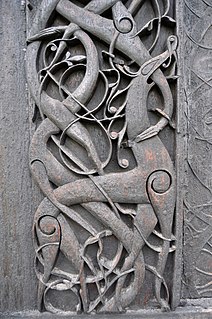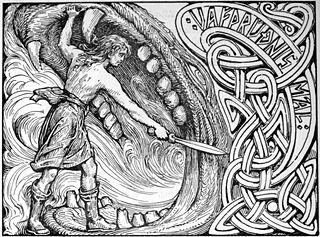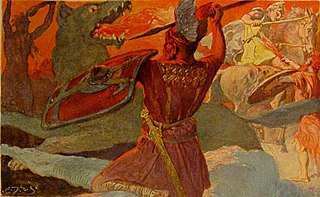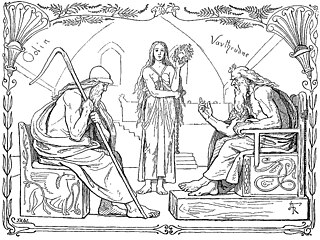
In Norse religion, Asgard is one of the Nine Worlds and home to the Æsir tribe of gods. It is surrounded by an incomplete wall attributed to a Hrimthurs riding the stallion Svaðilfari, according to Gylfaginning. Odin and his wife, Frigg, are the rulers of Asgard.

Bragi is the skaldic god of poetry in Norse mythology.

In Germanic mythology, Frigg, Frija, Frea (Langobardic), and Frige is a goddess. In nearly all sources, she is described as the wife of the god Odin. In Old High German and Old Norse sources, she is also connected with the goddess Fulla. The English weekday name Friday bears her name.

In Norse mythology, Ragnarök (; is a series of events, including a great battle, foretold to lead to the death of a number of great figures, natural disasters and the submersion of the world in water. After these events, the world will resurface anew and fertile, the surviving and returning gods will meet and the world will be repopulated by two human survivors. Ragnarök is an important event in Norse mythology and has been the subject of scholarly discourse and theory in the history of Germanic studies.

In Norse mythology, Sleipnir is an eight-legged horse ridden by Odin. Sleipnir is attested in the Poetic Edda, compiled in the 13th century from earlier traditional sources, and the Prose Edda, written in the 13th century by Snorri Sturluson. In both sources, Sleipnir is Odin's steed, is the child of Loki and Svaðilfari, is described as the best of all horses, and is sometimes ridden to the location of Hel. The Prose Edda contains extended information regarding the circumstances of Sleipnir's birth, and details that he is grey in color.

In Norse mythology, Víðarr is a god among the Æsir associated with vengeance. Víðarr is described as the son of Odin and the jötunn Gríðr, and is foretold to avenge his father's death by killing the wolf Fenrir at Ragnarök, a conflict which he is described as surviving. Víðarr is attested in the Poetic Edda, compiled in the 13th century from earlier traditional sources, the Prose Edda, written in the 13th century by Snorri Sturluson, and is interpreted as depicted with Fenrir on the Gosforth Cross. A number of theories surround the figure, including theories around potential ritual silence and a Proto-Indo-European basis.

In Norse mythology, Hel, the location, shares a name with Hel, a being who rules over the location. In late Icelandic sources, varying descriptions of Hel are given and various figures are described as being buried with items that will facilitate their journey to Hel after their death. In the Poetic Edda, Brynhildr's trip to Hel after her death is described and Odin, while alive, also visits Hel upon his horse Sleipnir. In Snorri Sturluson's Prose Edda, Baldr goes to Hel on his death and subsequently Hermóðr uses Sleipnir to attempt to retrieve him.

Mímir or Mimir is a figure in Norse mythology, renowned for his knowledge and wisdom, who is beheaded during the Æsir-Vanir War. Afterward, the god Odin carries around Mímir's head and it recites secret knowledge and counsel to him.
In Norse mythology, Bestla is the mother of the gods Odin, Vili and Vé by way of Borr, the sister of an unnamed being who assisted Odin, and the daughter or, depending on source, granddaughter of the jötunn Bölþorn. Bestla is attested in the Poetic Edda, compiled in the 13th century from earlier traditional sources, the Prose Edda, written in the 13th century by Snorri Sturluson, and in the poetry of skalds. Scholars have commented on the obscurity of the figure's name and have proposed that she may be the wise being Mímir's sister.

In Norse mythology, the einherjar are those who have died in battle and are brought to Valhalla by valkyries. In Valhalla, the einherjar eat their fill of the nightly-resurrecting beast Sæhrímnir, and valkyries bring them mead. The einherjar prepare daily for the events of Ragnarök, when they will advance for an immense battle at the field of Vígríðr.

In Norse mythology, Fólkvangr is a meadow or field ruled over by the goddess Freyja where half of those that die in combat go upon death, while the other half go to the god Odin in Valhalla. Fólkvangr is attested in the Poetic Edda, compiled in the 13th century from earlier traditional sources, and the Prose Edda, written in the 13th century by Snorri Sturluson. According to the Prose Edda, within Fólkvangr is Freyja's hall Sessrúmnir. Scholarly theories have been proposed about the implications of the location.
In Norse mythology, Glaðsheimr is a realm in Asgard where Odin's hall of Valhalla is located according to Grímnismál.

In Norse mythology, Vígríðr or Óskópnir is a large field foretold to host a battle between the forces of the gods and the forces of Surtr as part of the events of Ragnarök. The field is attested in the Poetic Edda, compiled in the 13th century from earlier traditional material, and in the Prose Edda, written by Snorri Sturluson in the 13th century. The Poetic Edda briefly mentions the field as where the two forces will battle, whereas the Prose Edda features a fuller account, foretelling that it is the location of the future death of several deities before the world is engulfed in flames and reborn.
In Norse mythology, Vingólf is one of the buildings of the gods. It is described as the hall or hörgr of the goddesses and also as a place where righteous men and those slain in battle go after death. It is mentioned in the Prose Edda, Gylfaginning 3 and in the enigmatic poem Hrafnagaldur Óðins.

In Norse mythology, Vafþrúðnismál is the third poem in the Poetic Edda. It is a conversation in verse form conducted initially between the Æsir Odin and Frigg, and subsequently between Odin and the giant Vafþrúðnir. The poem goes into detail about the Norse cosmogony and was evidently used extensively as a source document by Snorri Sturluson in the construction of the Prose Edda who quotes it. The poem is preserved in Codex Regius and partially in AM 748 I 4to. There are preservation problems relating to stanzas 40-41.

Odin is a fictional character appearing in American comic books published by Marvel Comics. The character is first mentioned in Journey into Mystery #85, then first appears in Journey into Mystery #86, and was adapted from the Odin of Norse mythology by Stan Lee and Jack Kirby. He is the father of Thor and former king of Asgard.
In Norse mythology, Meili is a god, son of the god Odin and brother of the god Thor. Meili is attested in the Poetic Edda, compiled in the 13th century from earlier traditional sources, and the Prose Edda, written in the 13th century by Snorri Sturluson. Other than Meili's relation to Odin and Thor, no additional information is provided about the deity in either source.

In Norse mythology, Mímisbrunnr is a well associated with the being Mímir, located beneath the world tree Yggdrasil. Mímisbrunnr is attested in the Poetic Edda, compiled in the 13th century from earlier traditional sources, and the Prose Edda, written in the 13th century by Snorri Sturluson. The well is located beneath one of three roots of the world tree Yggdrasil, a root that passes into the land of the frost jötnar where the primordial plane of Ginnungagap once existed. In addition, the Prose Edda relates that the water of the well contains much wisdom, and that Odin sacrificed one of his eyes to the well in exchange for a drink.















